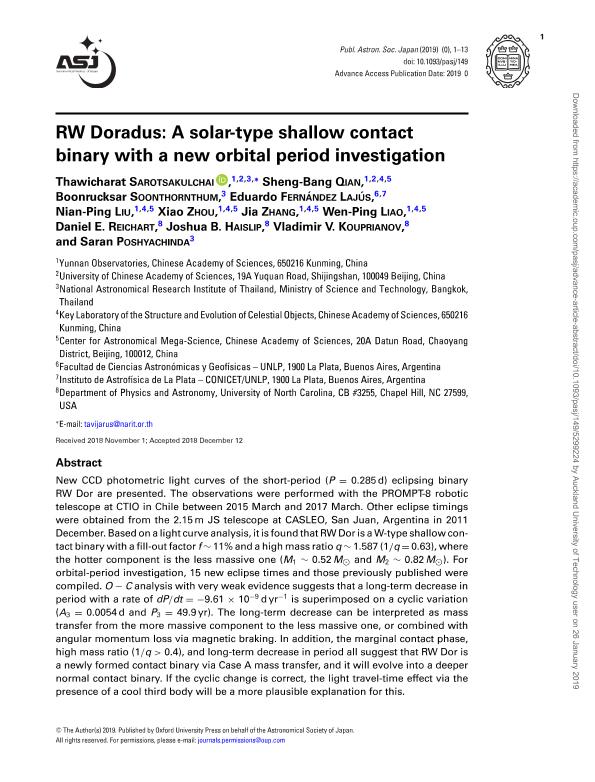Mostrar el registro sencillo del ítem
dc.contributor.author
Sarotsakulchai, Thawicharat

dc.contributor.author
Qian, Sheng Bang
dc.contributor.author
Soonthornthum, Boonrucksar
dc.contributor.author
Fernandez Lajus, Eduardo Eusebio

dc.contributor.author
Liu, Nian Ping
dc.contributor.author
Zhou, Xiao
dc.contributor.author
Zhang, Jia
dc.contributor.author
Liao, Wen Ping
dc.contributor.author
Reichart, Daniel E.
dc.contributor.author
Haislip, Joshua B.
dc.contributor.author
Kouprianov, Vladimir V.
dc.contributor.author
Poshyachinda, Saran
dc.date.available
2021-02-12T18:37:53Z
dc.date.issued
2019-01-23
dc.identifier.citation
Sarotsakulchai, Thawicharat; Qian, Sheng Bang; Soonthornthum, Boonrucksar; Fernandez Lajus, Eduardo Eusebio; Liu, Nian Ping; et al.; RW Doradus: A solar-type shallow contact binary with a new orbital period investigation; Astronomical Soc Japan; Publications Of The Astronomical Society Of Japan; 71; 2; 23-1-2019; 1-13
dc.identifier.issn
0004-6264
dc.identifier.uri
http://hdl.handle.net/11336/125623
dc.description.abstract
New CCD photometric light curves of the short-period (P = 0.285 d) eclipsing binary RW Dor are presented. The observations were performed with the PROMPT-8 robotic telescope at CTIO in Chile between 2015 March and 2017 March. Other eclipse timings were obtained from the 2.15 m JS telescope at CASLEO, San Juan, Argentina in 2011 December. Based on a light curve analysis, it is found that RW Dor is a W-type shallow contact binary with a fill-out factor f ∼ 11% and a high mass ratio q ∼ 1.587 (1/q = 0.63), where the hotter component is the less massive one (M1 ∼ 0.52 M and M2 ∼ 0.82 M). For orbital-period investigation, 15 new eclipse times and those previously published were compiled. O − C analysis with very weak evidence suggests that a long-term decrease in period with a rate of dP/dt = −9.61 × 10−9 d yr−1 is superimposed on a cyclic variation(A3 = 0.0054 d and P3 = 49.9 yr). The long-term decrease can be interpreted as mass transfer from the more massive component to the less massive one, or combined with angular momentum loss via magnetic braking. In addition, the marginal contact phase, high mass ratio (1/q > 0.4), and long-term decrease in period all suggest that RW Dor is a newly formed contact binary via Case A mass transfer, and it will evolve into a deepernormal contact binary. If the cyclic change is correct, the light travel-time effect via the presence of a cool third body will be a more plausible explanation for this.
dc.format
application/pdf
dc.language.iso
eng
dc.publisher
Astronomical Soc Japan

dc.rights
info:eu-repo/semantics/openAccess
dc.rights.uri
https://creativecommons.org/licenses/by-nc-sa/2.5/ar/
dc.subject
BINARIES: CLOSE
dc.subject
BINARIES: ECLIPSING
dc.subject
STARS: EVOLUTION
dc.subject
STARS: INDIVIDUAL (RW DORADUS)
dc.subject.classification
Astronomía

dc.subject.classification
Ciencias Físicas

dc.subject.classification
CIENCIAS NATURALES Y EXACTAS

dc.title
RW Doradus: A solar-type shallow contact binary with a new orbital period investigation
dc.type
info:eu-repo/semantics/article
dc.type
info:ar-repo/semantics/artículo
dc.type
info:eu-repo/semantics/publishedVersion
dc.date.updated
2020-11-19T22:02:36Z
dc.journal.volume
71
dc.journal.number
2
dc.journal.pagination
1-13
dc.journal.pais
Japón

dc.description.fil
Fil: Sarotsakulchai, Thawicharat. University of Chinese Academy of Sciences; China. National Astronomical Research Institute of Thailand; Tailandia. Chinese Academy of Sciences; República de China
dc.description.fil
Fil: Qian, Sheng Bang. Chinese Academy of Sciences; República de China. University of Chinese Academy of Sciences; China
dc.description.fil
Fil: Soonthornthum, Boonrucksar. National Astronomical Research Institute of Thailand; Tailandia
dc.description.fil
Fil: Fernandez Lajus, Eduardo Eusebio. Consejo Nacional de Investigaciones Científicas y Técnicas. Centro Científico Tecnológico Conicet - La Plata. Instituto de Astrofísica La Plata. Universidad Nacional de La Plata. Facultad de Ciencias Astronómicas y Geofísicas. Instituto de Astrofísica La Plata; Argentina
dc.description.fil
Fil: Liu, Nian Ping. Chinese Academy of Sciences; República de China
dc.description.fil
Fil: Zhou, Xiao. Chinese Academy of Sciences; República de China
dc.description.fil
Fil: Zhang, Jia. Chinese Academy of Sciences; República de China
dc.description.fil
Fil: Liao, Wen Ping. Chinese Academy of Sciences; República de China
dc.description.fil
Fil: Reichart, Daniel E.. University of North Carolina; Estados Unidos
dc.description.fil
Fil: Haislip, Joshua B.. University of North Carolina; Estados Unidos
dc.description.fil
Fil: Kouprianov, Vladimir V.. University of North Carolina; Estados Unidos
dc.description.fil
Fil: Poshyachinda, Saran. National Astronomical Research Institute of Thailand; Tailandia
dc.journal.title
Publications Of The Astronomical Society Of Japan

dc.relation.alternativeid
info:eu-repo/semantics/altIdentifier/url/https://academic.oup.com/pasj/article/71/2/34/5305914?searchresult=1
dc.relation.alternativeid
info:eu-repo/semantics/altIdentifier/doi/https://doi.org/10.1093/pasj/psy149
Archivos asociados
